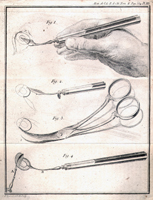 Jacques Daviel (1696-1762) was born August 11, 1696 in the Normandy area of France. He studied medicine and worked in Provence with patients suffering with the plague. He was then appointed surgeon to the city of Marseilles. Starting in 1728 he narrowed his practice to ophthalmology and in 1746 resettled in Paris. Three years later Daviel was appointed surgeon-oculist to the King of France. In this position, he attended not only the monarch but also the royal families in Spain and the Hapsburg Empire. In his later years, Daviel’s poor health drew him to the baths in Bourbon and Geneva, the latter being his place of death on September 30, 1762.
Jacques Daviel (1696-1762) was born August 11, 1696 in the Normandy area of France. He studied medicine and worked in Provence with patients suffering with the plague. He was then appointed surgeon to the city of Marseilles. Starting in 1728 he narrowed his practice to ophthalmology and in 1746 resettled in Paris. Three years later Daviel was appointed surgeon-oculist to the King of France. In this position, he attended not only the monarch but also the royal families in Spain and the Hapsburg Empire. In his later years, Daviel’s poor health drew him to the baths in Bourbon and Geneva, the latter being his place of death on September 30, 1762.
 Cataract surgery in the early 16th Century was performed by couching the cataract. If the procedure had complications, a few surgeons like Daviel would consider surgically removing the lens. He began to study the best method to treat cataracts and on April 8, 1747 Jacques Daviel performed the first modern cataract surgery by purposely making a corneal incision to remove the lens. In 1752 Daviel reported on his cases to the French Academy of Surgery.
Cataract surgery in the early 16th Century was performed by couching the cataract. If the procedure had complications, a few surgeons like Daviel would consider surgically removing the lens. He began to study the best method to treat cataracts and on April 8, 1747 Jacques Daviel performed the first modern cataract surgery by purposely making a corneal incision to remove the lens. In 1752 Daviel reported on his cases to the French Academy of Surgery.
Daviel’s procedure required several instruments including a corneal knife, forceps or scissors, a blunted needle, spatula and spoon. Daviel recommended using the fingers so that the “cataract is gently pushed into the anterior chamber and from there onto the cheek.” Post operatively the eyes were bathed in a mixture of water and wine, covered by a cotton dressing, and patients were required to lay on their backs in a darkened room for approximately 8 days.